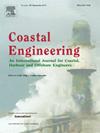Regular and random wave modelling over mild uniform bathymetry using SWASH
IF 4.5
2区 工程技术
Q1 ENGINEERING, CIVIL
引用次数: 0
Abstract
The modelling of coastal waves is challenging in light of their complex behaviour driven by a range of interacting physical effects such as nonlinear amplification, wave breaking and the influence of bathymetry. However, their accurate modelling and understanding is fundamental in the design of coastal structures. Many numerical models have been established to accurately capture these effects. One notable example is SWASH, which is readily used in industry to provide insight on structural designs. The present study assesses the applicability, validity and accuracy of SWASH to model regular and irregular waves propagating over mild bathymetries from intermediate water depth up to the shoreline. Particular emphasis is placed on the model’s ability to capture the effects of shoaling, wave reflection and breaking with accuracy yet reasonable computational cost. This is addressed through an analysis into the spatial distribution of crest height and wave height statistics. The accuracy of the numerical model is subsequently established through comparisons to equivalent sea-states generated experimentally. SWASH is shown to perform well in modelling sea-states of local steepness with 2% accuracy. However, caution should be taken in modelling steeper sea-states dominated by breaking, where underestimation in normalised crest heights and wave heights of up to 18% are observed compared to experimental measurements.
使用SWASH在温和均匀水深上进行规则和随机波模拟
沿海波浪的建模是具有挑战性的,因为它们的复杂行为受到一系列相互作用的物理效应的驱动,如非线性放大、波浪破碎和测深的影响。然而,它们的准确建模和理解是沿海结构设计的基础。已经建立了许多数值模型来准确地捕捉这些影响。一个值得注意的例子是SWASH,它很容易在工业中用于提供结构设计的见解。本研究评估了SWASH模型的适用性、有效性和准确性,以模拟从中等水深到海岸线在温和水深上传播的规则和不规则波。特别强调的是模型的能力,以准确而合理的计算成本捕获浅滩,波浪反射和破裂的影响。这是通过分析波峰高度和波高统计的空间分布来解决的。随后,通过与实验产生的等效海况进行比较,确定了数值模式的准确性。SWASH在模拟局部陡度为Hs/d<;0.3的海况方面表现良好,精度为2%。然而,在模拟以破碎为主的更陡峭海况时应谨慎,与实验测量值相比,在这种情况下,对归一化波峰高度和波高的低估高达18%。
本文章由计算机程序翻译,如有差异,请以英文原文为准。
求助全文
约1分钟内获得全文
求助全文
来源期刊

Coastal Engineering
工程技术-工程:大洋
CiteScore
9.20
自引率
13.60%
发文量
0
审稿时长
3.5 months
期刊介绍:
Coastal Engineering is an international medium for coastal engineers and scientists. Combining practical applications with modern technological and scientific approaches, such as mathematical and numerical modelling, laboratory and field observations and experiments, it publishes fundamental studies as well as case studies on the following aspects of coastal, harbour and offshore engineering: waves, currents and sediment transport; coastal, estuarine and offshore morphology; technical and functional design of coastal and harbour structures; morphological and environmental impact of coastal, harbour and offshore structures.
 求助内容:
求助内容: 应助结果提醒方式:
应助结果提醒方式:


